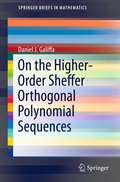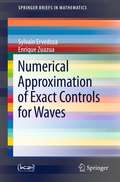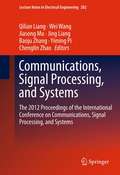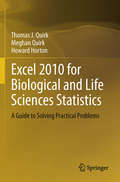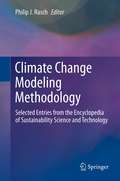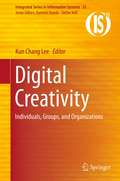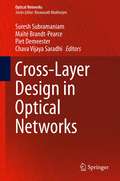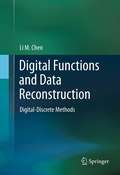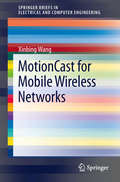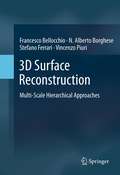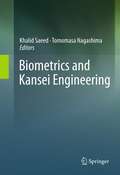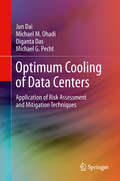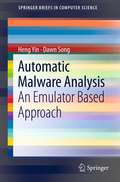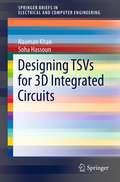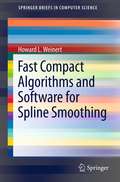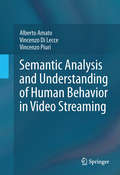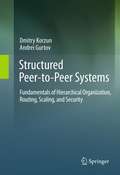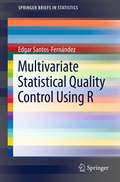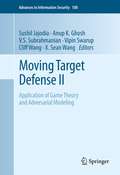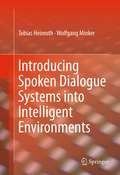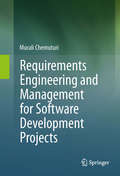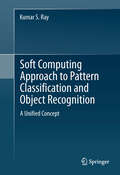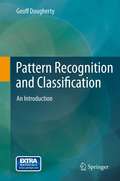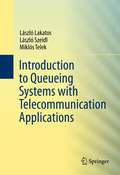- Table View
- List View
Excel 2007 for Biological and Life Sciences Statistics
by Meghan Quirk Thomas J Quirk Howard HortonThis is the first book to show the capabilities of Microsoft Excel to teach biological and life sciences statistics effectively. It is a step-by-step exercise-driven guide for students and practitioners who need to master Excel to solve practical science problems. If understanding statistics isn't your strongest suit, you are not especially mathematically-inclined, or if you are wary of computers, this is the right book for you. Excel, a widely available computer program for students and managers, is also an effective teaching and learning tool for quantitative analyses in science courses. Its powerful computational ability and graphical functions make learning statistics much easier than in years past. However, Excel 2007 for Biological and Life Sciences Statistics: A Guide to Solving Practical Problems is the first book to capitalize on these improvements by teaching students and managers how to apply Excel to statistical techniques necessary in their courses and work. Each chapter explains statistical formulas and directs the reader to use Excel commands to solve specific, easy-to-understand science problems. Practice problems are provided at the end of each chapter with their solutions in an appendix. Separately, there is a full Practice Test (with answers in an Appendix) that allows readers to test what they have learned.
On the Higher-Order Sheffer Orthogonal Polynomial Sequences
by Daniel J. GaliffaOn the Higher-Order Sheffer Orthogonal Polynomial Sequences sheds light on the existence/non-existence of B-Type 1 orthogonal polynomials. This book presents a template for analyzing potential orthogonal polynomial sequences including additional higher-order Sheffer classes. This text not only shows that there are no OPS for the special case the B-Type 1 class, but that there are no orthogonal polynomial sequences for the general B-Type 1 class as well. Moreover, it is quite provocative how the seemingly subtle transition from the B-Type 0 class to the B-Type 1 class leads to a drastically more difficult characterization problem. Despite this issue, a procedure is established that yields a definite answer to our current characterization problem, which can also be extended to various other characterization problems as well. Accessible to undergraduate students in the mathematical sciences and related fields, This book functions as an important reference work regarding the Sheffer sequences. The author takes advantage of Mathematica 7 to display unique detailed code and increase the reader's understanding of the implementation of Mathematica 7 and facilitate further experimentation. In addition, this book provides an excellent example of how packages like Mathematica 7 can be used to derive rigorous mathematical results.
Numerical Approximation of Exact Controls for Waves
by Enrique Zuazua Sylvain ErvedozaThis book is devoted to fully developing and comparing the two main approaches to the numerical approximation of controls for wave propagation phenomena: the continuous and the discrete. This is accomplished in the abstract functional setting of conservative semigroups.The main results of the work unify, to a large extent, these two approaches, which yield similaralgorithms and convergence rates. The discrete approach, however, gives not only efficient numerical approximations of the continuous controls, but also ensures some partial controllability properties of the finite-dimensional approximated dynamics. Moreover, it has the advantage of leading to iterative approximation processes that converge without a limiting threshold in the number of iterations. Such a threshold, which is hard to compute and estimate in practice, is a drawback of the methods emanating from the continuous approach. To complement this theory, the book provides convergence results for the discrete wave equation when discretized using finite differences and proves the convergence of the discrete wave equation with non-homogeneous Dirichlet conditions. The first book to explore these topics in depth, "On the Numerical Approximations of Controls for Waves" has rich applications to data assimilation problems and will be of interest to researchers who deal with wave approximations.
Communications, Signal Processing, and Systems: The 2012 Proceedings of the International Conference on Communications, Signal Processing, and Systems (Lecture Notes in Electrical Engineering #202)
by Qilian Liang Yiming Pi Wei Wang Jiasong Mu Jing Liang Baoju Zhang Chenglin ZhaoCommunications, Signal Processing, and Systems is a collection of contributions coming out of the International Conference on Communications, Signal Processing, and Systems (CSPS) held August 2012. This book provides the state-of-art developments of Communications, Signal Processing, and Systems, and their interactions in multidisciplinary fields, such as audio and acoustic signal processing. The book also examines Radar Systems, Chaos Systems, Visual Signal Processing and Communications and VLSI Systems and Applications. Written by experts and students in the fields of Communications, Signal Processing, and Systems.
Excel 2010 for Biological and Life Sciences Statistics
by Thomas J Quirk Meghan Quirk Howard HortonThis is the first book to show the capabilities of Microsoft Excel to teach biological and life sciences statistics effectively. It is a step-by-step exercise-driven guide for students and practitioners who need to master Excel to solve practical science problems. If understanding statistics isn't your strongest suit, you are not especially mathematically-inclined, or if you are wary of computers, this is the right book for you. Excel, a widely available computer program for students and managers, is also an effective teaching and learning tool for quantitative analyses in science courses. Its powerful computational ability and graphical functions make learning statistics much easier than in years past. However, Excel 2010 for Biological and Life Sciences Statistics: A Guide to Solving Practical Problems is the first book to capitalize on these improvements by teaching students and managers how to apply Excel to statistical techniques necessary in their courses and work. Each chapter explains statistical formulas and directs the reader to use Excel commands to solve specific, easy-to-understand science problems. Practice problems are provided at the end of each chapter with their solutions in an appendix. Separately, there is a full Practice Test (with answers in an Appendix) that allows readers to test what they have learned.
Climate Change Modeling Methodology: Selected Entries from the Encyclopedia of Sustainability Science and Technology
by Philip J. RaschThe Earth's average temperature has risen by 1.4°F over the past century, and computer models project that it will rise much more over the next hundred years, with significant impacts on weather, climate, and human society. Many climate scientists attribute these increases to the build up of greenhouse gases produced by the burning of fossil fuels and to the anthropogenic production of short-lived climate pollutants. Climate Change Modeling Methodologies: Selected Entries from the Encyclopaedia of Sustainability Science and Technology provides readers with an introduction to the tools and analysis techniques used by climate change scientists to interpret the role of these forcing agents on climate. Readers will also gain a deeper understanding of the strengths and weaknesses of these models and how to test and assess them. The contributions include a glossary of key terms and a concise definition of the subject for each topic, as well as recommendations for sources of more detailed information.
Digital Creativity
by Kun Chang LeeAs the use of digital technology has grown, so necessarily has the body of research into its effects at the personal, group and organizational levels, but there is no one book that looks at how digital technology has specifically influenced creativity. Digital Creativity: Individuals, Groups, and Organizations discusses all spectrums of influence that digital technologies have on creativity from the individual, team, and organization level. This book offers a new kind of creativity model encompassing all three levels of creativity. It combines each level into a unified creativity framework in which organizations regardless of their industry types could benefit in reengineering their business processes as well as strategies. For this purpose, the book considers various factors that would affect creativity- individuals' digital efficacy, heterogeneity among members (i.e., age, gender, races, tenure, education, and culture, etc), CMC (Computer-Mediated Communication), task complexity, exploitation, exploration, culture, organizational learning capability, and knowledge networks among members. This book introduces a theorized and systematic glimpse into the exciting realm of digital creativity. It is organized with contents starting from individuals to teams and ultimately to organizations, each with various techniques and cases. Each chapter shows how individuals, teams, and organizations can become more creative through use of digital technologies.
Cross-Layer Design in Optical Networks (Optical Networks #15)
by Chava Vijaya Saradhi Maïté Brandt-Pearce Suresh Subramaniam Piet DemeesterThis work addresses the topic of optical networks cross-layer design with a focus on physical-layer-impairment-aware design. Contributors captures both the physical-layer-aware network design as well as the latest advances in service-layer-aware network design. Treatment of topics such as, optical transmissions which are prone to signal impairments, dense packing of wavelengths, dispersion, crosstalk, etc., as well as how to design the network to mitigate such impairments, are all covered.
Digital Functions and Data Reconstruction
by Li M. ChenDigital Functions and Data Reconstruction: Digital-Discrete Methods provides a solid foundation to the theory of digital functions and its applications to image data analysis, digital object deformation, and data reconstruction. This new method has a unique feature in that it is mainly built on discrete mathematics with connections to classical methods in mathematics and computer sciences. Digitally continuous functions and gradually varied functions were developed in the late 1980s. A. Rosenfeld (1986) proposed digitally continuous functions for digital image analysis, especially to describe the "continuous" component in a digital image, which usually indicates an object. L. Chen (1989) invented gradually varied functions to interpolate a digital surface when the boundary appears to be continuous. In theory, digitally continuous functions are very similar to gradually varied functions. Gradually varied functions are more general in terms of being functions of real numbers; digitally continuous functions are easily extended to the mapping from one digital space to another. This will be the first book about digital functions, which is an important modern research area for digital images and digitalized data processing, and provides an introduction and comprehensive coverage of digital function methods. Digital Functions and Data Reconstruction: Digital-Discrete Methods offers scientists and engineers who deal with digital data a highly accessible, practical, and mathematically sound introduction to the powerful theories of digital topology and functional analysis, while avoiding the more abstruse aspects of these topics.
MotionCast for Mobile Wireless Networks
by Xinbing WangMotionCast for Mobile Wireless Networks provides an overview on the research for mobile ad-hoc networks regarding capacity and connectivity. Wireless ad-hoc networks are useful when there is a lack of infrastructure for communication. The proposed notion "MotionCast" is for the capacity analysis of multicast in MANET. A new kind of connectivity (k;m)-connectivity, is also defined, and its critical transmission range for i.i.d. (independently and identically distributed) and random walk mobility models are derived respectively. This book also investigates the related issues of connectivity in mobile and static circumstances. In addition, it provides a survey of the capacity scaling research, which gives a good summary of this field.
3D Surface Reconstruction: Multi-Scale Hierarchical Approaches
by Vincenzo Piuri Francesco Bellocchio N. Alberto Borghese Stefano Ferrari3D Surface Reconstruction: Multi-Scale Hierarchical Approaches presents methods to model 3D objects in an incremental way so as to capture more finer details at each step. The configuration of the model parameters, the rationale and solutions are described and discussed in detail so the reader has a strong understanding of the methodology. Modeling starts from data captured by 3D digitizers and makes the process even more clear and engaging. Innovative approaches, based on two popular machine learning paradigms, namely Radial Basis Functions and the Support Vector Machines, are also introduced. These paradigms are innovatively extended to a multi-scale incremental structure, based on a hierarchical scheme. The resulting approaches allow readers to achieve high accuracy with limited computational complexity, and makes the approaches appropriate for online, real-time operation. Applications can be found in any domain in which regression is required. 3D Surface Reconstruction: Multi-Scale Hierarchical Approaches is designed as a secondary text book or reference for advanced-level students and researchers in computer science. This book also targets practitioners working in computer vision or machine learning related fields.
Biometrics and Kansei Engineering
by Tomomasa Nagashima Khalid SaeedBiometrics and Kansei Engineering is the first book to bring together the principles and applications of each discipline. The future of biometrics is in need of new technologies that can depend on people's emotions and the prediction of their intention to take an action. Behavioral biometrics studies the way people walk, talk, and express their emotions, and Kansei Engineering focuses on interactions between users, products/services and product psychology. They are becoming quite complementary. This book also introduces biometric applications in our environment, which further illustrates the close relationship between Biometrics and Kansei Engineering. Examples and case studies are provided throughout this book. Biometrics and Kansei Engineering is designed as a reference book for professionals working in these related fields. Advanced-level students and researchers studying computer science and engineering will find this book useful as a reference or secondary text book as well.
Optimum Cooling of Data Centers
by Jun Dai Michael M. Ohadi Diganta Das Michael G. PechtThis book describes the use of free air cooling to improve the efficiency of, and cooling of, equipment for use in telecom infrastructures. Discussed at length is the cooling of communication installation rooms such as data centers or base stations, and this is intended as a valuable tool for the people designing and manufacturing key parts of communication networks. This book provides an introduction to current cooling methods used for energy reduction, and also compares present cooling methods in use in the field. The qualification methods and standard reliability assessments are reviewed, and their inability to assess the risks of free air cooling is discussed. The method of identifying the risks associated with free air cooling on equipment performance and reliability is introduced. A novel method of assessment for free air cooling is also proposed that utilizes prognostics and health management (PHM). This book also: Describes how the implementation of free air cooling can save energy for cooling within the telecommunications infrastructure. Analyzes the potential risks and failures of mechanisms possible in the implementation of free air cooling, which benefits manufacturers and equipment designers. Presents prognostics-based assessments to identify and mitigate the risks of telecommunications equipment under free air cooling conditions, which can provide the early warning of equipment failures at operation stage without disturbing the data centers' service. Optimum Cooling for Data Centers is an ideal book for researchers and engineers interested in designing and manufacturing equipment for use in telecom infrastructures.
Automatic Malware Analysis: An Emulator Based Approach (SpringerBriefs in Computer Science)
by Heng Yin Dawn SongMalicious software (i.e., malware) has become a severe threat to interconnected computer systems for decades and has caused billions of dollars damages each year. A large volume of new malware samples are discovered daily. Even worse, malware is rapidly evolving becoming more sophisticated and evasive to strike against current malware analysis and defense systems. Automatic Malware Analysis presents a virtualized malware analysis framework that addresses common challenges in malware analysis. In regards to this new analysis framework, a series of analysis techniques for automatic malware analysis is developed. These techniques capture intrinsic characteristics of malware, and are well suited for dealing with new malware samples and attack mechanisms.
Designing TSVs for 3D Integrated Circuits
by Nauman Khan Soha HassounThis book explores the challenges and presents best strategies for designing Through-Silicon Vias (TSVs) for 3D integrated circuits. It describes a novel technique to mitigate TSV-induced noise, the GND Plug, which is superior to others adapted from 2-D planar technologies, such as a backside ground plane and traditional substrate contacts. The book also investigates, in the form of a comparative study, the impact of TSV size and granularity, spacing of C4 connectors, off-chip power delivery network, shared and dedicated TSVs, and coaxial TSVs on the quality of power delivery in 3-D ICs. The authors provide detailed best design practices for designing 3-D power delivery networks. Since TSVs occupy silicon real-estate and impact device density, this book provides four iterative algorithms to minimize the number of TSVs in a power delivery network. Unlike other existing methods, these algorithms can be applied in early design stages when only functional block- level behaviors and a floorplan are available. Finally, the authors explore the use of Carbon Nanotubes for power grid design as a futuristic alternative to Copper.
Fast Compact Algorithms and Software for Spline Smoothing
by Howard L. WeinertFast Compact Algorithms and Software for Spline Smoothing investigates algorithmic alternatives for computing cubic smoothing splines when the amount of smoothing is determined automatically by minimizing the generalized cross-validation score. These algorithms are based on Cholesky factorization, QR factorization, or the fast Fourier transform. All algorithms are implemented in MATLAB and are compared based on speed, memory use, and accuracy. An overall best algorithm is identified, which allows very large data sets to be processed quickly on a personal computer.
Semantic Analysis and Understanding of Human Behavior in Video Streaming
by Vincenzo Piuri Alberto Amato Vincenzo Di LecceSemantic Analysis and Understanding of Human Behaviour in Video Streaming investigates the semantic analysis of the human behaviour captured by video streaming, and introduces both theoretical and technological points of view. Video analysis based on the semantic content is in fact still an open issue for the computer vision research community, especially when real-time analysis of complex scenes is concerned. This book explores an innovative, original approach to human behaviour analysis and understanding by using the syntactical symbolic analysis of images and video streaming described by means of strings of symbols. A symbol is associated to each area of the analyzed scene. When a moving object enters an area, the corresponding symbol is appended to the string describing the motion. This approach allows for characterizing the motion of a moving object with a word composed by symbols. By studying and classifying these words we can categorize and understand the various behaviours. The main advantage of this approach lies in the simplicity of the scene and motion descriptions so that the behaviour analysis will have limited computational complexity due to the intrinsic nature both of the representations and the related operations used to manipulate them. Besides, the structure of the representations is well suited for possible parallel processing, thus allowing for speeding up the analysis when appropriate hardware architectures are used. A new methodology for design systems for hierarchical high semantic level analysis of video streaming in narrow domains is also proposed. Guidelines to design your own system are provided in this book. Designed for practitioners, computer scientists and engineers working within the fields of human computer interaction, surveillance, image processing and computer vision, this book can also be used as secondary text book for advanced-level students in computer science and engineering.
Structured Peer-to-Peer Systems
by Dmitry Korzun Andrei GurtovThe field of structured P2P systems has seen fast growth upon the introduction of Distributed Hash Tables (DHTs) in the early 2000s. The first proposals, including Chord, Pastry, Tapestry, were gradually improved to cope with scalability, locality and security issues. By utilizing the processing and bandwidth resources of end users, the P2P approach enables high performance of data distribution which is hard to achieve with traditional client-server architectures. The P2P computing community is also being actively utilized for software updates to the Internet, P2PSIP VoIP, video-on-demand, and distributed backups. The recent introduction of the identifier-locator split proposal for future Internet architectures poses another important application for DHTs, namely mapping between host permanent identity and changing IP address. The growing complexity and scale of modern P2P systems requires the introduction of hierarchy and intelligence in routing of requests. Structured Peer-to-Peer Systems covers fundamental issues in organization, optimization, and tradeoffs of present large-scale structured P2P systems, as well as, provides principles, analytical models, and simulation methods applicable in designing future systems. Part I presents the state-of-the-art of structured P2P systems, popular DHT topologies and protocols, and the design challenges for efficient P2P network topology organization, routing, scalability, and security. Part II shows that local strategies with limited knowledge per peer provide the highest scalability level subject to reasonable performance and security constraints. Although the strategies are local, their efficiency is due to elements of hierarchical organization, which appear in many DHT designs that traditionally are considered as flat ones. Part III describes methods to gradually enhance the local view limit when a peer is capable to operate with larger knowledge, still partial, about the entire system. These methods were formed in the evolution of hierarchical organization from flat DHT networks to hierarchical DHT architectures, look-ahead routing, and topology-aware ranking. Part IV highlights some known P2P-based experimental systems and commercial applications in the modern Internet. The discussion clarifies the importance of P2P technology for building present and future Internet systems.
Multivariate Statistical Quality Control Using R
by Edgar Santos-FernándezThe intensive use of automatic data acquisition system and the use of cloud computing for process monitoring have led to an increased occurrence of industrial processes that utilize statistical process control and capability analysis. These analyses are performed almost exclusively with multivariate methodologies. The aim of this Brief is to present the most important MSQC techniques developed in R language. The book is divided into two parts. The first part contains the basic R elements, an introduction to statistical procedures, and the main aspects related to Statistical Quality Control (SQC). The second part covers the construction of multivariate control charts, the calculation of Multivariate Capability Indices.
Moving Target Defense II
by Anup K. Ghosh Sushil Jajodia X. Sean Wang Vipin Swarup Cliff Wang V. S. SubrahmanianOur cyber defenses are static and are governed by lengthy processes, e.g., for testing and security patch deployment. Adversaries could plan their attacks carefully over time and launch attacks at cyber speeds at any given moment. We need a new class of defensive strategies that would force adversaries to continually engage in reconnaissance and re-planning of their cyber operations. One such strategy is to present adversaries with a moving target where the attack surface of a system keeps changing. Moving Target Defense II: Application of Game Theory and Adversarial Modeling includes contributions from world experts in the cyber security field. In the first volume of MTD, we presented MTD approaches based on software transformations, and MTD approaches based on network and software stack configurations. In this second volume of MTD, a group of leading researchers describe game theoretic, cyber maneuver, and software transformation approaches for constructing and analyzing MTD systems. Designed as a professional book for practitioners and researchers working in the cyber security field, advanced -level students and researchers focused on computer science will also find this book valuable as a secondary text book or reference.
Introducing Spoken Dialogue Systems into Intelligent Environments
by Wolfgang Minker Tobias HeinrothIntroducing Spoken Dialogue Systems into Intelligent Environments outlines the formalisms of a novel knowledge-driven framework for spoken dialogue management and presents the implementation of a model-based Adaptive Spoken Dialogue Manager(ASDM) called OwlSpeak. The authors have identified three stakeholders that potentially influence the behavior of the ASDM: the user, the SDS, and a complex Intelligent Environment (IE) consisting of various devices, services, and task descriptions. The theoretical foundation of a working ontology-based spoken dialogue description framework, the prototype implementation of the ASDM, and the evaluation activities that are presented as part of this book contribute to the ongoing spoken dialogue research by establishing the fertile ground of model-based adaptive spoken dialogue management. This monograph is ideal for advanced undergraduate students, PhD students, and postdocs as well as academic and industrial researchers and developers in speech and multimodal interactive systems.
Requirements Engineering and Management for Software Development Projects
by Murali ChemuturiRequirements Engineering and Management for Software Development Projects presents a complete guide on requirements for software development including engineering, computer science and management activities. It is the first book to cover all aspects of requirements management in software development projects. This book introduces the understanding of the requirements, elicitation and gathering, requirements analysis, verification and validation of the requirements, establishment of requirements, different methodologies in brief, requirements traceability and change management among other topics. The best practices, pitfalls, and metrics used for efficient software requirements management are also covered. Intended for the professional market, including software engineers, programmers, designers and researchers, this book is also suitable for advanced-level students in computer science or engineering courses as a textbook or reference.
Soft Computing Approach to Pattern Classification and Object Recognition
by Kumar S. RaySoft Computing Approach to Pattern Classification and Object Recognition establishes an innovative, unified approach to supervised pattern classification and model-based occluded object recognition. The book also surveys various soft computing tools, fuzzy relational calculus (FRC), genetic algorithm (GA) and multilayer perceptron (MLP) to provide a strong foundation for the reader. The supervised approach to pattern classification and model-based approach to occluded object recognition are treated in one framework , one based on either a conventional interpretation or a new interpretation of multidimensional fuzzy implication (MFI) and a novel notion of fuzzy pattern vector (FPV). By combining practice and theory, a completely independent design methodology was developed in conjunction with this supervised approach on a unified framework, and then tested thoroughly against both synthetic and real-life data. In the field of soft computing, such an application-oriented design study is unique in nature. The monograph essentially mimics the cognitive process of human decision making, and carries a message of perceptual integrity in representational diversity. Soft Computing Approach to Pattern Classification and Object Recognition is intended for researchers in the area of pattern classification and computer vision. Other academics and practitioners will also find the book valuable.
Pattern Recognition and Classification
by Geoff DoughertyThe use of pattern recognition and classification is fundamental to many of the automated electronic systems in use today. However, despite the existence of a number of notable books in the field, the subject remains very challenging, especially for the beginner. Pattern Recognition and Classification presents a comprehensive introduction to the core concepts involved in automated pattern recognition. It is designed to be accessible to newcomers from varied backgrounds, but it will also be useful to researchers and professionals in image and signal processing and analysis, and in computer vision. Fundamental concepts of supervised and unsupervised classification are presented in an informal, rather than axiomatic, treatment so that the reader can quickly acquire the necessary background for applying the concepts to real problems. More advanced topics, such as semi-supervised classification, combining clustering algorithms and relevance feedback are addressed in the later chapters. This book is suitable for undergraduates and graduates studying pattern recognition and machine learning.
Introduction to Queueing Systems with Telecommunication Applications
by Laszlo Lakatos Miklos Telek Laszlo SzeidlThe book is composed of two main parts: mathematical background and queueing systems with applications. The mathematical background is a self containing introduction to the stochastic processes of the later studies queueing systems. It starts with a quick introduction to probability theory and stochastic processes and continues with chapters on Markov chains and regenerative processes. More recent advances of queueing systems are based on phase type distributions, Markov arrival processes and quasy birth death processes, which are introduced in the last chapter of the first part. The second part is devoted to queueing models and their applications. After the introduction of the basic Markovian (from M/M/1 to M/M/1//N) and non-Markovian (M/G/1, G/M/1) queueing systems, a chapter presents the analysis of queues with phase type distributions, Markov arrival processes (from PH/M/1 to MAP/PH/1/K). The next chapter presents the classical queueing network results and the rest of this part is devoted to the application examples. There are queueing models for bandwidth charing with different traffic classes, slotted multiplexers, ATM switches, media access protocols like Aloha and IEEE 802.11b, priority systems and retrial systems. An appendix supplements the technical content with Laplace and z transformation rules, Bessel functions and a list of notations. The book contains examples and exercises throughout and could be used for graduate students in engineering, mathematics and sciences.

